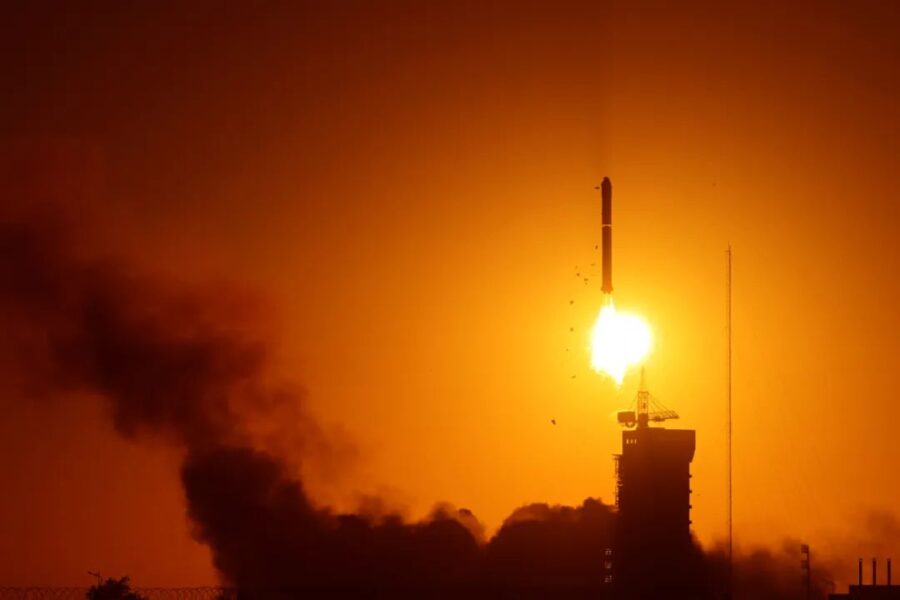China Has Sent up the ASO-S Space Observatory to Study Solar Flares, Eruptions, and the Sun’s Magnetic Field

The Advanced Space-based Solar Observatory (ASO-S) lifted off atop a Long March 2D rocket from the Jiuquan Satellite Launch Center in the Gobi Desert at 7:43 p.m. EDT / 23:43 UT on October 8th.
ASO-S is planned to operate at 720 kilometers (447 miles) above Earth’s surface in a Sun-synchronous orbit that will allow it to observe the Sun at all times. Its primary, four-year mission is timed to make the most of the 2024–2025 solar maximum, when the Sun is at its most active during its 11-year cycle.
With its three instruments — the Full-disk solar vector MagnetoGraph (FMG), the Lyman-alpha Solar Telescope (LST), and the solar Hard X-ray Imager (HXI) — ASO-S will observe the magnetic field and its changes, as well as the energy built up and released from the Sun and its inner corona in the form of flares and coronal mass ejections (CMEs).
The huge surges of solar radiation in solar flares and the violent eruptions of plasma and high energy particles contained in CMEs depend on fluctuations in the Sun’s powerful, writhing magnetic fields. But the causal relationship between the magnetic dynamo in the Sun and the events we can see is not fully understood.
ASO-S’s observations will also be used to support space-weather forecasts and warnings of hazardous events. CMEs can damage satellites, pose dangers for astronauts in orbit and, in the case of particularly large events, even threaten infrastructure on Earth.

Fig. 2 Watch the launch of ASO-S. (Image by OurSpace)
ASO-S, nicknamed Kuafu 1 after a mythological giant that wanted to capture the Sun, will observe the Sun’s full disk at extreme ultraviolet wavelengths and peer into its inner corona, with the aim of gaining insight into how the magnetic field influences the propagation of CMEs and helping to predict these events.
Getting a dedicated solar mission off the ground has been a long endeavor. Mission lead Gan Weiqun (Purple Mountain Observatory, China), told Sky & Telescope via email that the Chinese solar community has dreamt of flying a solar observatory since the 1970s. “The most exciting thing is that we realized a dream made almost 50 years ago,” Gan says. “I hope from now on that we can go step by step and be involved in the space solar family.”
Another small, experimental mission will complement the work of ASO-S: the Chinese H-alpha Solar Explorer (CHASE), launched October 2021, is observing of the full solar disk at the wavelength of hydrogen-alpha, which captures activity in ionized hydrogen.
Data from the ASO-S mission will be made freely available; Gan told CCTV after launch that an international program will train scientists how to download and use the data and relevant software.
The ASO-S mission was first proposed back in 2011 and entered an intensive study phase in 2014. The Chinese Academy of Sciences (CAS) approved it in late 2017, as part of a second round of missions of the academy’s space science program.
The first round of missions to be approved consisted of the Dark Matter Particle Explorer, the Mozi quantum experiment satellite, the Hard X-ray Modulation Telescope, and Shijian 10, a retrievable microgravity experiment spacecraft. These missions launched between late 2015 and 2017.
The new round, besides ASO-S, includes the Solar wind Magnetosphere Ionosphere Link Explorer, a joint mission between CAS and the European Space Agency; the Einstein Probe, focused on violent cosmic events; and the Gravitational wave high-energy Electromagnetic Counterpart All-sky Monitor that will follow up on gravitational-wave signals.
The CAS is currently assessing a new batch of 13 candidate missions proposed in its third round.
This report is published online by SKY&TELESCOPE.